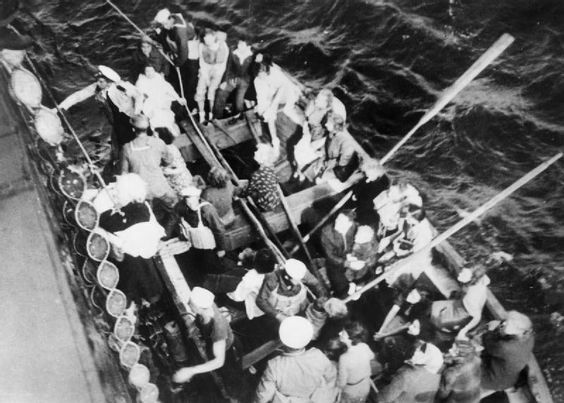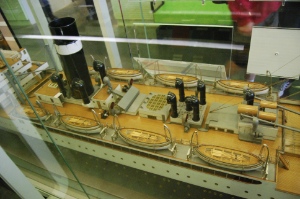
At Sea In a Lifeboat : After the Sinking of the SS Athenia
Sunday, 9:10 – 11:00 a.m., September 3
Everything on board Lifeboat 7A seemed chaotic and worrisome to Russell. Seated on the starboard side behind the last cross-bench, he discovered he could reach over the gunwale and put his hand in the cold ocean. He thought it was dangerous for the boat to be riding so low in the water and worried about how he would survive without a lifejacket if they sank.
Russell’s biggest concern was the water inside the boat. In addition to the missing plug for the rainwater drain, there were several other leaks in the wooden hull. As passengers discovered the leaks, they tore off bits of clothing to wedge into the cracks, but still the water seeped in. The bailing bucket wasn’t enough, so a few of the men used their shoes to dump out water, while some women bailed water with their purses. It was exhausting work and after fifteen minutes or so, people began to slow down or take a breather, at which point the water level slowly began to rise and the frantic activity started all over.
The only Athenia crewman aboard was an older man who worked as a waiter in the Tourist dining saloon, someone had said. Russell wondered if his lack of experience was the reason why he struggled to guide the boat and direct the people at the oars. The passengers in the boat had only been able to find three of its eight oarlocks, leaving the port side of the boat underpowered. Without a tiller, the steward used one of the extra oars to try to steer the boat, but Russell didn’t think it had much effect.
On the cross-bench ahead of him, he watched two women struggle to work one of the oars. Coordinating their actions in response to the steward’s directions looked difficult and they were often out of synch with the starboard oar of the people ahead of them.
“Starboard side stop rowing,” the steward at the back of the boat called out. “You ladies on the right side of the boat stop for a moment and let the portside come around.” They stopped rowing, but Russell could see the confusion in their faces. One woman let go of the oar altogether while the second one turned around to look at the bow. At that moment, a wave swept the oar out of the oarlock and it fell overboard as the first women screamed in surprise.
Russell quickly reached over the gunwale and got a hand on the heavy oar, keeping it from drifting away from the boat.
“Don’t let go, sonny,” someone shouted. Several passengers seated near him reached out to pull the oar back into the boat and secure it the oarlock, where the two women once again took possession of it.
“Good work, laddie,” the steward called out.
“Well done.”
“Quick thinking, son.” Several people offered congratulations and a few clapped him on the shoulder with their thanks. Even though there were other unused oars in the boat, Russell felt genuinely appreciated by the adults. A sense of belonging began to replace the loneliness that had accompanied him into the lifeboat.
In our next blog: A rescue ship appears in the night.
For the series of blogs please visit www.thomascsanger.com


